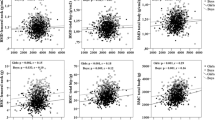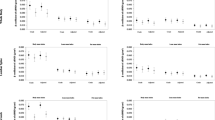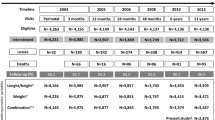Abstract
Summary
Lower birth weight has a negative association with adult BMC and body composition in young adult Swedish women.
Introduction
The aim of this study was to evaluate the influence of birth weight on peak bone mass and body composition in a cohort of 25-year-old women.
Methods
One thousand sixty-one women participated in this cross-sectional population-based study using dual energy X-ray absorptiometry (DXA) to assess bone mineral content (BMC), bone mineral density (BMD), and body composition (total body (TB), femoral neck (FN), total hip (TH), lumbar spine L1–L4 (LS), and lean and fat mass). Birth weight data was available for 1,047 women and was categorized into tertiles of low (≤3,180 g), intermediate (3,181–3,620 g), and high (≥3,621 g) birth weight.
Results
Significant correlations were observed between birth weight and TB-BMC (r = 0.159, p < 0.001), FN-BMC (r = 0.096, p < 0.001), TH-BMC (r = 0.102, p = 0.001), LS-BMC (r = 0.095, p = 0.002), and lean mass (r = 0.215, p < 0.001). No correlation was observed between birth weight and BMD. The estimated magnitude of effect was equivalent to a 0.3–0.5 SD difference in BMC for every 1 kg difference in birth weight (151 g (TB); 0.22 g (FN); 1.5 g (TH), 2.5 kg TB lean mass). The strongest correlations between birth weight and BMC occurred in women with lowest birth weights, although excluding women who weighed <2,500 g at birth, and the correlation remained significant although slightly weaker.
Conclusions
Women with lower birth weight have lower BMC and less lean and fat mass at the age of 25, independent of current body weight. Lower birth weight has a greater negative influence on bone mass than the positive influence of higher birth weight.


Similar content being viewed by others
References
Rozenberg S et al (1997) The brittle bone: how to save women from osteoporosis. Int J Fertil Womens Med 42(2):101–106
Bonjour JP et al (2009) The importance and relevance of peak bone mass in the prevalence of osteoporosis. Salud Publ Mex 51(Suppl 1):S5–S17
Pesonen J et al (2005) High bone mineral density among perimenopausal women. Osteoporos Int 16(12):1899–1906
Teegarden D et al (1995) Peak bone mass in young women. J Bone Miner Res 10(5):711–715
Haapasalo H et al (1996) Development of mass, density, and estimated mechanical characteristics of bones in Caucasian females. J Bone Miner Res 11(11):1751–1760
Berger C et al (2010) Peak bone mass from longitudinal data: implications for the prevalence, pathophysiology, and diagnosis of osteoporosis. J Bone Miner Res 25(9):1948–1957
Eisman JA (1999) Genetics of osteoporosis. Endocr Rev 20(6):788–804
Jouanny P et al (1995) Environmental and genetic factors affecting bone mass. Similarity of bone density among members of healthy families. Arthritis Rheum 38(1):61–67
Slemenda CW et al (1991) Genetic determinants of bone mass in adult women: a reevaluation of the twin model and the potential importance of gene interaction on heritability estimates. J Bone Miner Res 6(6):561–567
Bonjour JP et al (1997) Calcium-enriched foods and bone mass growth in prepubertal girls: a randomized, double-blind, placebo-controlled trial. J Clin Invest 99(6):1287–1294
Johnston CC Jr et al (1992) Calcium supplementation and increases in bone mineral density in children. N Engl J Med 327(2):82–87
Welten DC et al (1994) Weight-bearing activity during youth is a more important factor for peak bone mass than calcium intake. J Bone Miner Res 9(7):1089–1096
Schlussel MM, Dos Santos J (2010) Vaz, and G. Kac, Birth weight and adult bone mass: a systematic literature review. Osteoporos Int 21(12):1981–1991
Gardsell P et al (1993) Predicting various fragility fractures in women by forearm bone densitometry: a follow-up study. Calcif Tissue Int 52(5):348–353
Melton LJ 3rd et al (2003) Relative contributions of bone density, bone turnover, and clinical risk factors to long-term fracture prediction. J Bone Miner Res 18(2):312–318
Cooper C et al (2002) The fetal origins of osteoporotic fracture. Calcif Tissue Int 70(5):391–394
Dennison E et al (1996) The programming of vertebral body size and mineral density in early life. Osteoporos Int 6(Supp 1):S277
Cooper C et al (1995) Childhood growth, physical activity, and peak bone mass in women. J Bone Miner Res 10(6):940–947
Cooper C et al (1997) Growth in infancy and bone mass in later life. Ann Rheum Dis 56(1):17–21
Baird J, et al 2010 Does birthweight predict bone mass in adulthood? A systematic review and meta-analysis. Osteoporosis International p. 1–12
Callréus M et al (2012) Self-reported recreational exercise combining regularity and impact is necessary to maximize bone mineral density in young adult women: a population-based study of 1,061 women 25 years of age. Osteoporos Int. doi:10.1007/s00198-011-1886-5
Syddall HE et al (2005) Birth weight, infant weight gain, and cause-specific mortality: the Hertfordshire Cohort study. Am J Epidemiol 161(11):1074–1080
Barker DJ et al (2002) Fetal origins of adult disease: strength of effects and biological basis. Int J Epidemiol 31(6):1235–1239
Hamed HM et al (1993) Influence of birth weight on adult bone mineral density. Osteoporos Int 3(1):1–2
Yarbrough DE, Barrett-Connor E, Morton DJ (2000) Birth weight as a predictor of adult bone mass in postmenopausal women: the Rancho Bernardo Study. Osteoporos Int 11(7):626–630
Gale CR et al (2001) Intrauterine programming of adult body composition. J Clin Endocrinol Metab 86(1):267–272
McGuigan FE et al (2002) Genetic and environmental determinants of peak bone mass in young men and women. J Bone Miner Res 17(7):1273–1279
Antoniades L et al (2003) Association of birth weight with osteoporosis and osteoarthritis in adult twins. Rheumatol (Oxf) 42(6):791–796
te Velde SJ et al (2004) Birth weight and musculoskeletal health in 36-year-old men and women: results from the Amsterdam Growth and Health Longitudinal Study. Osteoporos Int 15(5):382–388
Laitinen J et al (2005) Body size from birth to adulthood and bone mineral content and density at 31 years of age: results from the northern Finland 1966 birth cohort study. Osteoporos Int 16(11):1417–1424
Pearce MS et al (2005) Lifecourse study of bone health at age 49–51 years: the Newcastle thousand families cohort study. J Epidemiol Community Health 59(6):475–480
Saito T et al (2005) Weight gain in childhood and bone mass in female college students. J Bone Miner Metab 23(1):69–75
Dennison EM et al (2005) Birth weight and weight at 1 year are independent determinants of bone mass in the seventh decade: the Hertfordshire cohort study. Pediatr Res 57(4):582–586
Dalziel SR et al (2006) Peak bone mass after exposure to antenatal betamethasone and prematurity: follow-up of a randomized controlled trial. J Bone Miner Res 21(8):1175–1186
Oliver H et al (2007) Growth in early life predicts bone strength in late adulthood: the Hertfordshire Cohort Study. Bone 41(3):400–405
Leunissen RW et al (2008) Influence of birth size and body composition on bone mineral density in early adulthood: the PROGRAM study. Clin Endocrinol (Oxf) 69(3):386–392
Hovi P et al (2009) Decreased bone mineral density in adults born with very low birth weight: a cohort study. PLoS Med 6(8):e1000135
El Hage R (2010) Birth weight is an independent determinant of whole body bone mineral content and bone mineral density in a group of Lebanese adolescent girls. J Bone Miner Metab 28(3):360–363
Schlussel MM et al (2010) Birth weight and bone mass in young adults from Brazil. Bone 46(4):957–963
Cummings SR et al (1994) Does estimating volumetric bone density of the femoral neck improve the prediction of hip fracture? A prospective study. Study of osteoporotic fractures research group. J Bone Miner Res 9(9):1429–1432
Bedogni G et al (2002) Relationship between body composition and bone mineral content in young and elderly women. Ann Hum Biol 29(5):559–565
El Hage RP et al (2009) Relative importance of lean and fat mass on bone mineral density in a group of adolescent girls and boys. Eur J Appl Physiol 105(5):759–764
Acknowledgments
This work was supported by grants from the Swedish Research Council (K2009-53X-14691-07-3), FAS (Grant 2007-2125), Grant Greta and Johan Kock Foundation, A Påhlsson Foundation, A Osterlund Foundation, the H Järnhardt foundation, King Gustav V and Queen Victoria Foundation, Apotekare Hedbergs Foundation, Malmö University Hospital Research Foundation, Research and Development Council of Region Skåne, Sweden, and the Swedish Medical Society.
Conflicts of interest
None.
Author information
Authors and Affiliations
Corresponding author
Rights and permissions
About this article
Cite this article
Callréus, M., McGuigan, F. & Åkesson, K. Birth weight is more important for peak bone mineral content than for bone density: the PEAK-25 study of 1,061 young adult women. Osteoporos Int 24, 1347–1355 (2013). https://doi.org/10.1007/s00198-012-2077-8
Received:
Accepted:
Published:
Issue Date:
DOI: https://doi.org/10.1007/s00198-012-2077-8




